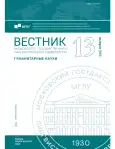THE ERRORS OF LEXICAL-SEMANTIC PARADIGMATICS IN THE RUSSIAN TRANSLATION OF CHINESE-LANGUAGE PUBLIC SIGNS
- Authors: Liu L.1, Wang L.2
-
Affiliations:
- Guangdong University of Foreign Languages and International Trade
- Shandong Normal University
- Issue: No 13(894) (2024)
- Pages: 76-82
- Section: Linguistics
- URL: https://journal-vniispk.ru/2542-2197/article/view/291530
- ID: 291530
Cite item
Full Text
Abstract
This paper uses Russian public signs filmed in China and Russia as corpus, applies comparative analysis, qualitative analysis and error analysis to examine and correct semantic paradigmatic errors in the Russian translation of Chinese public notices, and explains the reasons for such errors. The findings indicate that the main issues in the Russian translation of Chinese public notices include semantic confusion of homonyms, misuse of synonyms, confusion between words with the same root and improper juxtaposition of hypernyms and hyponyms.
About the authors
Lifen Liu
Guangdong University of Foreign Languages and International Trade
Author for correspondence.
Email: liulifen1993@163.com
Doctor of philology, Professor at the Translation Studies Research Center and the Institute of European Languages and Cultures of Guangdong University of Foreign Languages and International Trade
ChinaLina Wang
Shandong Normal University
Email: linawang0122@sina.com
PhD in philology, Senior Lecturer at the Institute of Foreign Languages of Shandong Normal University
ChinaReferences
- Liu Lifen (2023). 公示语 (social signs) and 语言景观 (linguistic landscape): linguistic terms and the concepts behind them. Vestnik of St. Petersburg State University. Oriental and African studies, 3, 588–602. (In Russ.)
- Liu Lifen, Li Min. (2023). Analysis of errors in the order of words when translating signs for public places in China into Russian. Political Linguistics, 4, 208–216. (In Russ.)
- 徐盛桓 (1983). 聚合和组合[J]. 外语教学. №10: 12–21 = Xu Sheng huan. (1983). Paradigmatics and syntagmatics. Teaching foreign languages, 10, 12–21. (In Chinese)
- Lekant, P. A. et al. (2007). Modern Russian language / P. A. Le can ta, E. I. Dibrova, L. L. Kasatkin, E. V. Klobukov. Moscow: Drofa. (In Russ.)
- Kharitonchik, Z. A. (1992). Lexicology of the English language. Minsk: Higher School. (In Russ.)
- Pustoshilo, E. P. (2011). Lexicology. phraseology. Lexicography: an educational and methodological complex in the Russian language for students of pedagogical specialties. Grodno: Grodno State University.
- Lysyakova, M. V. (2005). Lexico-semantic paradigms: linguistic status, criteria of differentiation. Vestnic of Peoples’ Friendship University of Russia. Linguistics, 7, 5-17. (In Russ.)
- 吴振国 (2000). 模糊语义的聚合 [J]. 语言研究. №4: 29–35 = Wu Zhenguo. (2000). Paradigmatics of fuzzy semantics. Language studies, 4, 29–35. (In Chinese)
- Golovnya, A. I. (2007). Homonymy as a system category of language. Minsk: Belarusian State University. (In Russ.)
- Yangaikina, T. I. (2007). Hyponymic (genus-species) relations between lexical units in the Moksha literary language. Vestnic of Chuvash University, 1, 251–258.
Supplementary files










